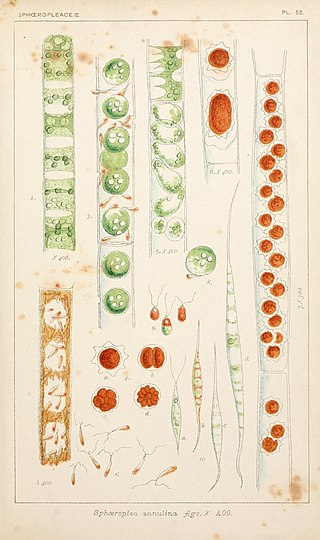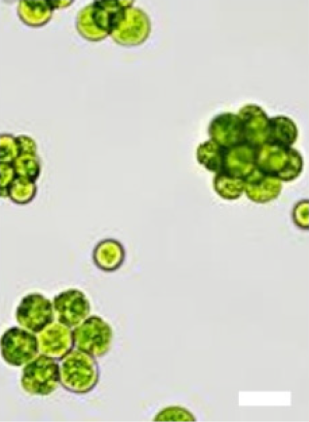
The Chlorophyceae are one of the classes of green algae, distinguished mainly on the basis of ultrastructural morphology. They are usually green due to the dominance of pigments chlorophyll a and chlorophyll b. The chloroplast may be discoid, plate-like, reticulate, cup-shaped, spiral- or ribbon-shaped in different species. Most of the members have one or more storage bodies called pyrenoids located in the chloroplast. Pyrenoids contain protein besides starch. Some green algae may store food in the form of oil droplets. They usually have a cell wall made up of an inner layer of cellulose and outer layer of pectose.
Pycnococcaceae is a family of green algae in the order Pseudoscourfieldiales. The defining features of this family include the single invagination of the pyrenoid where the mitochondrial membrane fits into it and the "decapore" - a ring of 10 pores through the thick cell wall.
Characiochloris is a genus of green algae in the family Characiochloridaceae. Characiochloris is epiphytic on freshwater algae, or found in soil.
Characiosiphon is a genus of green algae in the family Characiosiphonaceae. It contains a single species, Characiosiphon rivularis.

Characium is a genus of green algae in the family Characiaceae. It is very commonly found in freshwater habitats, where it is attached to phytoplankton or zooplankton.
Coelastropsis is a genus of green algae in the family Scenedesmaceae, containing the single species Coelastropsis costata. It is found in freshwater lakes and bogs, usually associated with mosses and filamentous algae. It has been recorded in Europe, Cuba and possibly New Zealand.

Golenkinia is a genus of green algae first described in 1894 by Robert Chodat. The genus is named for the Russian phycologist Mikhail Iljitsch Golenkin. Golenkinia species live in fresh water and are found around the world.
Lobocharacium is a genus of green algae in the family Characiosiphonaceae. It contains the single species Lobocharacium coloradoense. It has been isolated from a pond in Colorado, United States.
Podohedriella is a genus of green algae in the family Selenastraceae. It is found in freshwater habitats or on damp wood.

Schroederia is a genus of green algae in the family Schroederiaceae. Schroederiaceae is a monotypic taxon; Schroederia is its only genus.

Sphaeroplea is a genus of green algae in the family Sphaeropleaceae. It was first circumscribed by the Swedish botanist Carl Adolph Agardh in 1824.

Desmidium is a genus of green algae, specifically of the Desmidiaceae.
Gilbertsmithia is a genus of green algae in the family Scenedesmaceae, containing the single species Gilbertsmithia grandis. It was named after the American botanist Gilbert Morgan Smith. This remarkable alga has only been recorded once from a muddy rainwater pool in Madras, India.
Actinochloridaceae is a family of green algae, in the order Chlamydomonadales.

Deasonia is a genus of green algae, in the family Actinochloridaceae. It is found in soils.
Characiellopsis is a genus of green algae in the family Characiaceae. Two species are known: Characiellopsis anophelesii and Characiellopsis skujae.
Deuterocharacium is a genus of green algae in the family Characiaceae. It is found in freshwater habitats, attached to algae or detritus. It is rare and has only been recorded from Europe.

Chlorokybus is a multicellular (sarcinoid) genus of basal green algae or charophyte. It has been classified as the sole member of the family Chlorokybaceae, which is the sole member of the order Chlorokybales, in turn the sole member of the class Chlorokybophyceae. It grows on soil and rock surfaces, and is rare.

Klebsormidium is a genus of filamentous charophyte green algae comprising 20 species. The name was proposed in 1972 to resolve confusion in application and status of Hormidium and was given for the German botanist Georg Albrecht Klebs.
Bracteamorpha is a genus of green algae in the order Sphaeropleales, and is the only genus in the family Bracteamorphaceae. It contains a single species, Bracteamorpha trainorii.








